Gary Engberg Outdoors
10106 Hwy. Y Mazomanie, WI. 53560
Phone & Fax 608 795-4208
E-mail gengberg@chorus.net
Web site: http://www.garyengbergoutdoors.com
Copyright Gary Engberg Outdoors 2018
Spring’s High Water Walleyes
It’s almost the beginning of March, that magic time of the year to walleye fishermen who’s been waiting all winter to fish and catch the river’s spring-run walleyes and saugers. This winter you’ve watched all the fishing shows on your satellite dish, read all the walleye articles in magazines, and seen all the videos you can of your favorite fish, the walleye. Now, it’s finally time to put everything that you’ve learned, read, and heard to use and go walleye fishing.
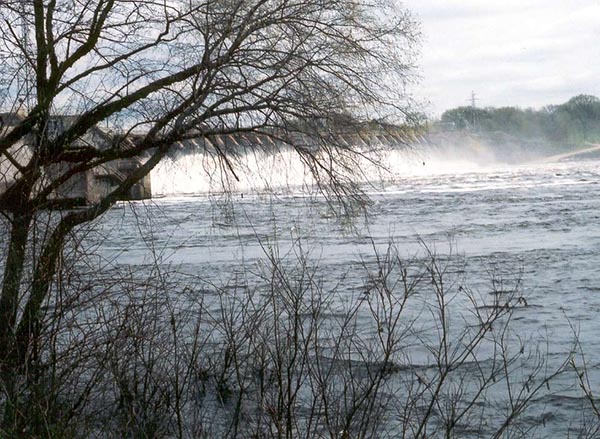
The roaring Wisconsin River in the spring.
It’s now springtime on river systems in the Upper Midwest. But, there’s one major problem everywhere and in Wisconsin for sure. The warmer temperature has caused the snow to rapidly melt throughout the walleye range and the spring has also brought showers and copious amounts of rain. You, the walleye angler, are ready to fish, but the rivers throughout the area have risen causing the waters to overflow the rivers banks and flood the backwaters and sloughs of the Wisconsin and Midwest rivers. The main channel of most rivers (like the Mississippi, Wisconsin, Rock, Crayfish, Pecatonica, Wolf, Fox, Black, Illinois, and Yellow Rivers) are extremely high with most dams having their gates wide open to let the rushing waters pass thru and continue to flow downriver. These normally placid rivers are now a fisherman’s nightmare to many anglers’ who are scared away and discouraged by the high water and strong current of most rivers.
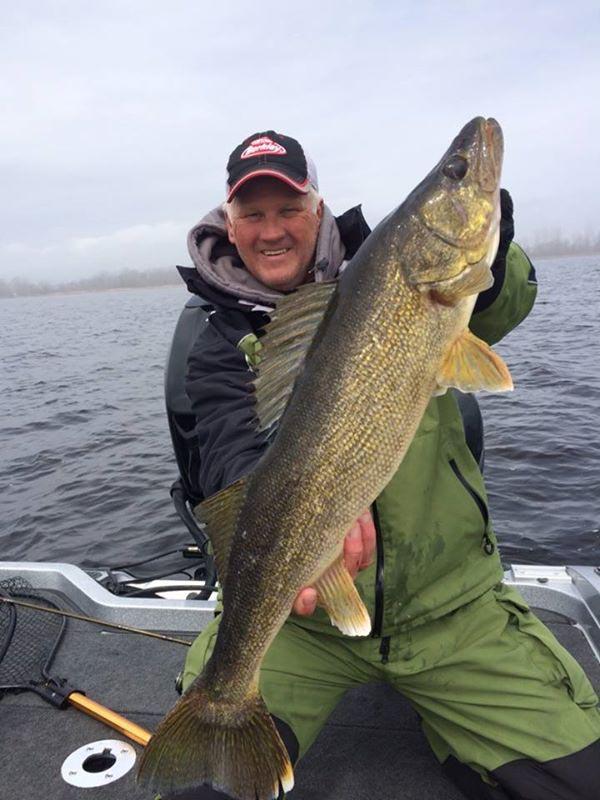
Bret Alexander with a big eye from the Fox River at Depere.
So, what does the average angler do to catch walleyes during this “difficult” fishing period? Try to remember that water temperatures are in the 40’s and low 50’s and day time temperatures are moderating. Female walleyes are getting close to spawning and staging in the river while looking for a suitable spawning site. But most importantly, the open dam gates and locks have allowed fresh water (with baitfish, bugs, and other organisms) into the river system which has been stagnate for months with the same “old” water. The fresh water has rejuvenated the entire river system, almost like turning on a switch, and this high water spring period is actually a great time to fish for walleyes and their close cousin, the sauger. But, where do these ready-to-spawn walleyes go during this period of high water and strong current?
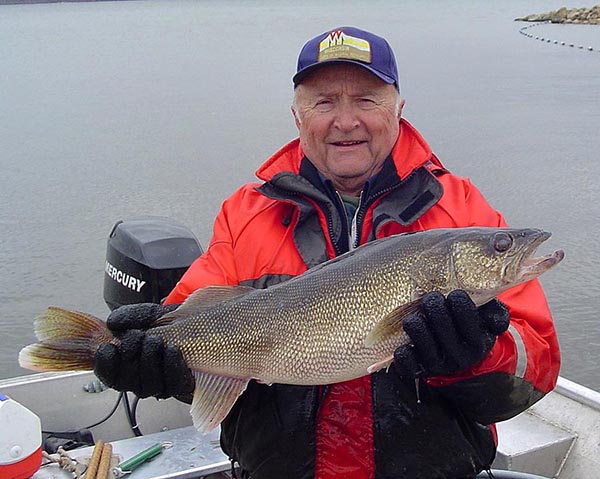
Wisconsin DNR Technician with a big 'eye.
Years ago, Mr. Walleye himself, Gary Roach, told me that during these periods of high water walleyes will move into shallow water and flooded timber and brush to get out of the river’s strong current and flow. River walleyes and all other river fish try to find any type of obstruction (rocks, bottom depressions, islands, river bends, wood, timber, bridge pilings) that breaks the current and allows the fish to hide behind the structure and wait for food to float by and then dash out and grab it before returning to their resting area. River walleyes and saugers are constantly fighting the current and must eat regularly just to maintain their body’s weight. The key for them is to find a location where they may wait to ambush food while conserving their precious energy by staying out of the strong current.
What walleye anglers must now do is to change their thinking and instead of thinking like a typical spring walleye angler who uses light jigs, live bait, light line, three-ways, and live bait rigs to try thinking like a bass angler and use some of their techniques and tactics. First, I suggest that anglers now switch to a heavier jig, a ¼ to 3/8th ounce jig, instead of the normal 1/16th or 1/8th ounce jig. The heavier jig in shallow water still works and walleyes will not know the difference. Second, I try to swim my jig a little faster back to the boat trying to just occasionally “tic” the bottom. If you drag a jig, you would have constant snags, break-offs, and a fishing nightmare. This is why you have to reel fast enough to prevent constant hang-ups and snags. Through experience, I’ve found that the Bait Rigs Slo-Poke and Weedmaster jigs really shine in these early conditions. I still lose jigs, but not at the rate of using a typical round-head jig. The design and shape of the Slo-Poke and Weedmaster allows the jig to slide through the brush and wood while preventing many lost jigs and snags.
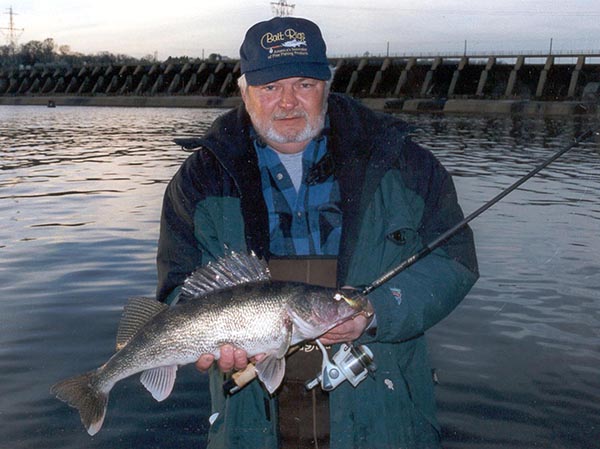
Bob Zownir of Madison with nice walleyes caught wading below the dam at Prairie du Sac in Sauk Prairie, Wi.
My third or last recommendation is to switch from using live bait (minnows this time of the year) to scented plastics like Berkley Power Bait, Gulp, and other plastics like the twister tails, shad tails, and ringworms made by companies like Kalins and Walleye Assassin. Plastics seem to stay on your jig’s hook longer than live bait and in shallow water, the flash, vibration, and profile of plastics work wonders. By experimentation and practice, the plastics made by Berkley, Kalins, and Walleye Assassin have all the qualities that you want and they come in great colors. Good colors for rivers are; electric blue, purple, motor oil, fire-tiger, white, yellow, chartreuse, and any of the above that have a fleck or sparkle in them. These companies make all sizes and also offer an array of fish-catching colors, but this time of the year I use a 4 or 5 inch plastic tail. This is because there are no hatches of baitfish in the river yet and the profile of the forage fish is a little larger in the spring. If you have plastics in the 3 inch to 5 inch range than you are covered for most situations that you’ll encounter.
The last and maybe the most important thing that I do are switching my line weight. Normally, I’ve used Berkley XT or XL in 6 pound test monofilament. But, by trial and error, I’ve found that 10 pound mono works just as well as the lighter test line in these high water and snag infested situations. Use the green Berkley Trilene mono too because it blends in with the stained water of the river. The 10 lb. test line allows you to pull out of most of the snags that you will encounter instead of losing more jigs. If I continued to use 6 pound test mono, I would constantly be re-tying or losing most of the jigs in my tackle box. You still will lose a few jigs and break off a few on the odd stump, but most of the time you will be able pull out of the snag and continue fishing under these less than ideal conditions.
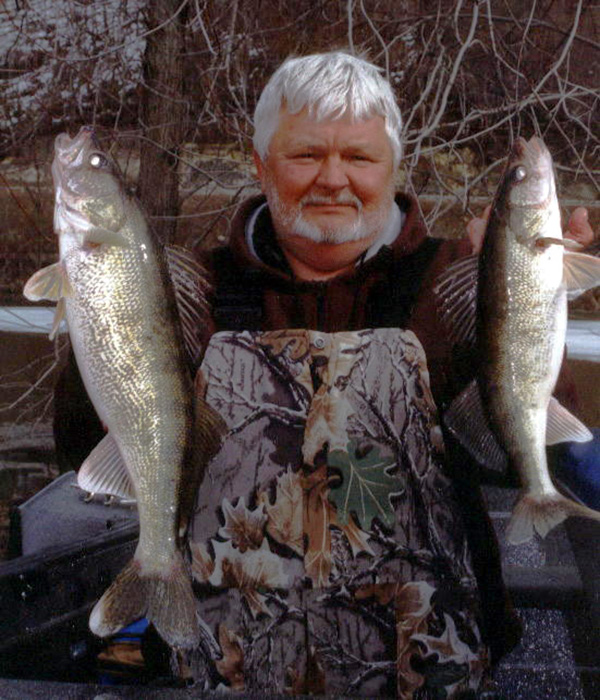
Zownir with another walleye caught wading below the Sauk Dam.
I don’t think that jig color or plastic color is the most important thing when fishing shallow water for spring walleyes. What gets the fish to strike is the flash, vibration, and getting the combo in the fish’s face so they don’t have to chase it very far. I still constantly change jig and tail color, just in case one of the two variables give a different profile or look to the bait that appeals to the walleye. Keep experimenting the day that you’re fishing till you find what works for you.
Remember, that the walleyes will be very shallow (under 5 feet) to get out of the strong current of the river, to feed on the baitfish that have also moved into the shallow’s brush and wood, and to look for a location to drop their eggs and finish spawning. To repeat the spring high water walleye keys; go shallow, right up and into the wood and trees, switch to a heavier line (10 lb. test), and try using plastics in lieu of live bait. Let the walleyes tell you what they want in bait size and profile, so keep experimenting till you find the pattern that day!
You can anchor outside these shallow and wooded spots and cast or pitch to the walleyes, or use a push pole to get back into the little pockets and openings, and wading is always another possibility this time of the year. I promise that the walleyes and saugers will be shallow and close to or in the shoreline wood during these high-water periods. You now have the best tactics and tips for high water walleyes.











